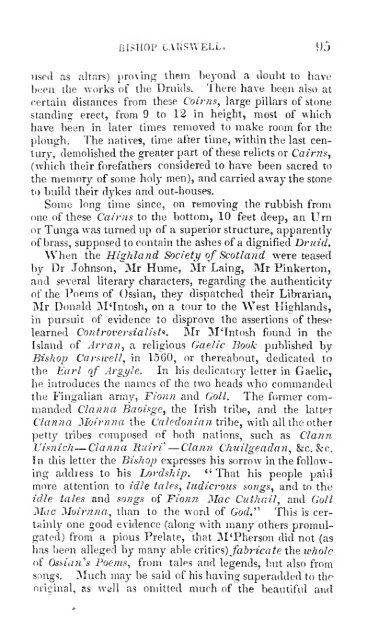An Laoidheadair Gaelic na ain spioradail
An Laoidheadair Gaelic na ain spioradail
An Laoidheadair Gaelic na ain spioradail
You also want an ePaper? Increase the reach of your titles
YUMPU automatically turns print PDFs into web optimized ePapers that Google loves.
BISHOP CAKSWELL, 95<br />
tisod tis altnrs) prnving ihem beyond a iloubt to have<br />
been the works of the Druids. 'lhere have bcen also at<br />
cert<strong>ain</strong> distances from these Coirns^ large pillars of stone<br />
standing erect, frora 9 to 12 in height, most of vvhich<br />
have been in later times removed to make room for the<br />
plough. The <strong>na</strong>tives, time after time, within the last century,<br />
demolished the greater part of these relicts or Cairns,<br />
(which iheir forefathers considered to have been sacred to<br />
the memnry of some holy men), and carried avvay the stone<br />
to buihl their dykes and out-houses.<br />
Some Inng time since, on removing the rubbish from<br />
nne nf these Cairns to the bottom, 10 feet deep, an Urn<br />
or Tunga was tumed up of a superior structure, apparently<br />
of brass, supposed to cont<strong>ain</strong> the ashes of a dignified Druid.<br />
When the Highland Society of Scotland were teased<br />
by Dr Johnson, Mr Hume, Mr L<strong>ain</strong>g, Mr Pinkerton,<br />
and several hterary characters, regarding the authenticity<br />
of the Poems of Ossian, they dispatched their Librarian,<br />
Mr Dn<strong>na</strong>ld M'Intosh, on a tour to the West Highlands,<br />
in pursait of evidence to disprove the assertions of these<br />
learned Controversialisto. Mr M'Intosh found in the<br />
Island of Arran, a religious <strong>Gaelic</strong> Book published by<br />
Bishop CarsweH, in 1560, nr thereabout, dedicated to<br />
the Earl of Argjjle. In his dedicatory letter in <strong>Gaelic</strong>,<br />
he introduces the <strong>na</strong>mes of the two heads Avho commanded<br />
the Fingalian army, Fionn and Goll. The former commanded<br />
Clan<strong>na</strong> Baoisge, the Irish tribe, and the latter<br />
Clan<strong>na</strong> Moirn<strong>na</strong> the Caledonian tribe, with all the other<br />
petty tribes composed of both <strong>na</strong>tions, such as Clann<br />
Uisnich— Clan<strong>na</strong> Ruiri'' — Clann Chuilgeadan, &c. &c.<br />
In this letter the Bishop expresses his sorrow in the following<br />
address to his Lordship. " That his people paid<br />
mnre attention to idle tales, ludicrous songs, and to the<br />
idìe tales and songs of Tionn Mac Cuthail, and Goll<br />
Mac Moirn<strong>na</strong>, than to the word of God.'''' TÌVìs is cert<strong>ain</strong>ly<br />
one good evidence (along with many others promulgated)<br />
from a pious Prelate, that IM'Pherson did not (as<br />
has been alleged by many able CT\i\cs)fabricate the wholc<br />
of Ossia?i^s Poems, from tales and legends, but also from<br />
songs. ìMuch may be said of his having superadded to thrnri£ri<strong>na</strong>l,<br />
as well as omitted much of ihe beautifnl aud

















